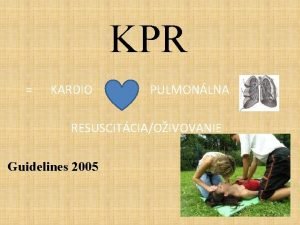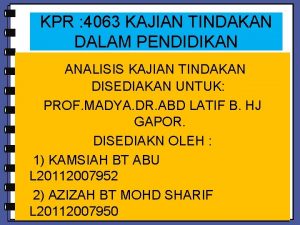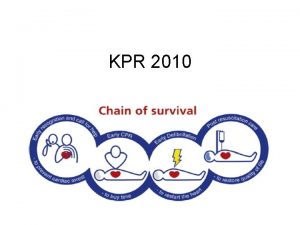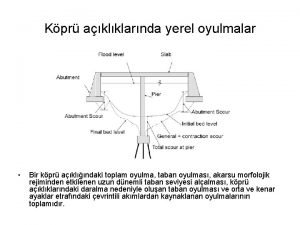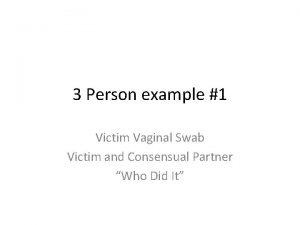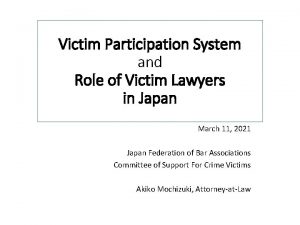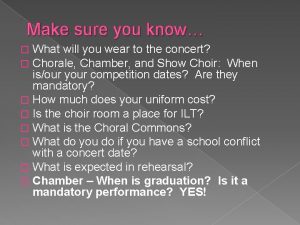KPR 2010 1 Make sure you the victim
















- Slides: 16

KPR 2010


1. Make sure you, the victim and any bystanders are safe. 2. Check the victim for a response: • gently shake his shoulders and ask loudly: “Are you all right? “ 3 a. If he responds: • leave him in the position in which you find him, provided there is no further danger; • try to find out what is wrong with him and get help if needed; • reassess him regularly. 3 b. If he does not respond: • shout for help ◦ turn the victim onto his back and then open the airway using head tilt and chin lift ◦ place your hand on his forehead and gently tilt his head back; ◦ with your fingertips under the point of the victim’s chin, lift the chin to open the airway.

gently shake his shoulders and ask loudly: “Are you all right? “

place your hand on his forehead and gently tilt his head back; ◦ with your fingertips under the point of the victim’s chin, lift the chin to open the airway

. Optimal chest compression technique comprises: compressing the chest at a rate of at least 100 min− 1 and to a depth of at least 5 cm (for an adult), but not exceeding 6 cm; allowing the chest to recoil completely after each compression taking approximately the same amount of time for compression as relaxation.


start chest compression as follows: ◦ kneel by the side of the victim; ◦ place the heel of one hand in the centre of the victim’s chest; (which is the lower half of the victim’s breastbone (sternum)); ◦ place the heel of your other hand on top of the first hand; ◦ interlock the fingers of your hands and ensure that pressure is not applied over the victim’s ribs. Keep your arms straight. Do not apply any pressure over the upper abdomen or the bottom end of the sternum. ◦ position yourself vertically above the victim’s chest and press down on the sternum at least 5 cm (but not exceeding 6 cm); ◦ after each compression, release all the pressure on the chest without losing contact between your hands and the sternum; repeat at a rate of at least 100 min− 1 (but not exceeding 120 min− 1); ◦ compression and release should take equal amounts of time.




• Adrenaline. – The optimal dose of adrenaline is not known – for VF/VT give adrenaline after the third shock once chest compressions have resumed, and then repeat every 3– 5 min during cardiac arrest – If the initial monitored rhythm is PEA or asystole, start CPR 30: 2 and give adrenaline 1 mg as soon as venous access is achieved. If no pulse is present (or if there is any doubt about the presence of a pulse), continue CPR. Give adrenaline 1 mg (IV) every alternate CPR cycle (i. e. , about every 3– 5 min) once vascular access is obtained. • Amiodaron – if VF/VT persists after three shocks, give 300 mg amiodarone by bolus injection. • • • A further dose of 150 mg may be given for recurrent or refractory VF/VT, followed by an infusion of 900 mg over 24 h sodium bicarbonate (50 mmol) if cardiac arrest is associated with hyperkalaemia or tricyclic antidepressant overdose; repeat the dose according to the clinical condition and the result of seriál blood gas analysis Atropine its routine use for asystole or PEA is no longer recommended

Use of ultrasound imaging has the potential to detect reversible causes of cardiac arrest cardiac tamponade, pulmonary embolism, aortic dissection, hypovolaemia, pneumothorax.


• Minimising the pre-shock pause The delay between stopping chest compressions and delivery of the shock (the pre-shock pause) must be kept to an absolute minimum; even 5– 10 s delay will reduce the chances of the shock being successful. • The pre-shock pause can easily be reduced to less than 5 s by continuing compressions during charging of the defibrillator and by having an efficient team coordinated by a leader who communicates effectively. – The safety check to ensure that nobody is in contact with the patient at the moment of defibrillation should be undertaken rapidly but efficiently.

Monofazický a bifazický výboj.
 Drawing conclusions meaning
Drawing conclusions meaning Kpr u dětí do 1 roka
Kpr u dětí do 1 roka şekildeki k p r üçgeninde
şekildeki k p r üçgeninde Proses kajian tindakan
Proses kajian tindakan Swagelok kpr
Swagelok kpr Are you sure you have a strategy
Are you sure you have a strategy Incremental plagiarism example
Incremental plagiarism example What is luchresi's role in the story?
What is luchresi's role in the story? Fashion pub quiz
Fashion pub quiz Be sure of this i am with you always
Be sure of this i am with you always Are you sure this is safe
Are you sure this is safe I am sure you have heard something like
I am sure you have heard something like The triangle shirtwaist factory fire commonlit answer key
The triangle shirtwaist factory fire commonlit answer key Sometimes when you innovate you make mistakes
Sometimes when you innovate you make mistakes Make the lie big
Make the lie big Go make a difference
Go make a difference Make the lie big, make it simple
Make the lie big, make it simple

